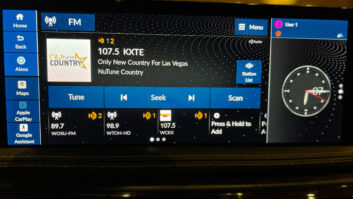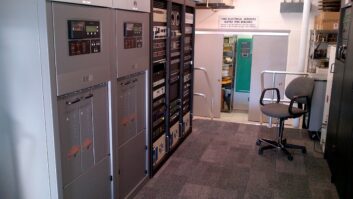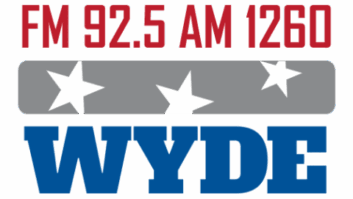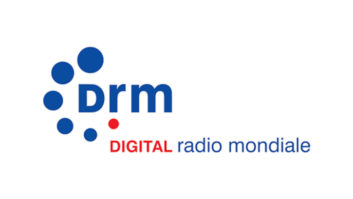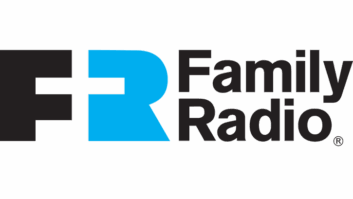We were just getting ready to leave the on-ramp and join all the other electronic media racing down the digital super highway. Uh-oh.
Funny noises coming out of the PAC transmission suddenly have forced HD Radio to the emergency lane in need of repairs.
This is not merely about hitting a pothole or changing a flat. There is a flaw in the vehicle that needs fixing.
As first reported by Radio World, the NRSC has temporarily halted the standards-setting process for HD Radio. The leaders of the DAB Subcommittee said the 36 kilobits-per-second PAC compression algorithm used for AM radio is simply not good enough to use as a systems standard. At least not yet.
Up until this bombshell, radio stations had been ordering and installing HD Radio transmission gear and receivers were promised for delivery to store shelves this summer. Many industry participants anxiously await the rollout of radio’s most important technological innovation in more than 50 years.
How damaging is this revelation to the HD Radio rollout? Will Ibiquity Digital be able to fix the problem quickly as promised? Only time will tell. We fervently hope they’ll deliver on that promise, but it will not be that easy.
PAC vs. MPEG
Ibiquity is now facing its own version of “dueling algorithms” in the battle of digital audio compression codecs.
MPEG Layer II was used in the early years of IBOC testing starting in 1991. Ibiquity’s predecessor, USA Digital Radio, tried very hard but failed to deliver an acceptable product using this codec up through the mid-1990s. MPEG introduced AAC in 1997 as the pursuit for an improved codec for low-bit-rate applications like IBOC and Internet streaming heated up. Competitor Lucent Digital Radio joined the fray in 1998 with its own modulation scheme and its PAC codec, after many other contenders for a digital radio transmission standard had fallen by the wayside.
Radio’s scaled-down version of a digital Grand Alliance emerged in 2000 when USADR and LDR decided to join forces, advancing the effort to forge a digital radio standard for the United States. Our highly-placed sources said at the time that Ibiquity would stop using MPEG AAC for HD Radio in favor of PAC, a Bell Labs and Lucent Digital Radio invention. Even though a number of the same engineers have been involved with the development of both codecs, MPEG was mostly a European invention. Several parties hold patents for the MPEG standard, primarily Franhofer, but also Sony, AT&T and Dolby Labs.
The parting of the ways between Ibiquity and Franhofer was not pretty. That bridge may have been burned beyond repair.
PAC initially was touted for its ability to perform at low bit rates. It no doubt made perfect sense for USADR to embrace it over MPEG when USADR and Lucent Digital Radio decided to merge. What they didn’t foresee was watching MPEG improve its compression algorithm to the point where many in the industry, including most of the leaders of the DAB subgroup, judge it as better than PAC for HD Radio.
Many engineers long have felt MPEG has been the world standard for compression codecs and were disappointed that Ibiquity chose PAC. Some NRSC members would prefer that Ibiquity bail out on PAC in favor of MPEG AAC+. Given the political and economic imperatives within Ibiquity, that is not likely to happen. It’d be too much like having the U.S. admit that the U.N. was right all along about how to best handle Saddam Hussein.
Applying the big fix
The challenge for any lossy digital compression scheme operating at low bit rates is preventing and concealing artifacts. When so much of the original data is left behind, artifacts are spawned and audio quality suffers.
The fallout for PAC on AM HD Radio appears in the form of gritty, unnatural-sounding voices with wispy and gurgling background effects not heard in the original source. Some also describe swirling or phasing sounds as well as platform-motion effects associated with Motorola AM stereo skywave reception. While most listeners may not hear this or deem such impairment significant, many of the engineers charged with recommending an industry standard do.
Most of the software tricks employed to fix this problem involve hiding the artifacts rather than eliminating them. The PAC engineers have been battling the issue for a long time. It’s been their primary focus for two years.
Finding an expedient fix that will fully satisfy the NRSC might be as easy as the United States installing a quick and stable democracy in Iraq – we want both, but both are likely to take longer than planners project.
In response to the NRSC decision, Ibiquity is suggesting that an acceptable fix will come in the form of software changes in a number of months. Not years. Whether the mavens of PAC can compress more artifact blood out of their invention in its present form in a few short months is dubious. Even AAC+ has artifacts at 36 kbps; theirs just don’t sound quite as irritating, it seems. That’s probably because AAC+ is more conservative and sounds a bit duller than PAC, which conveys more high-frequency detail and impact.
Squeezing out improvement
The big stumbling block for making IBOC work well has always been restricted bandwidth. To comply with the NRSC masks, data rates for digital transmission had to be reduced. Only so many bits will fit in the existing AM and FM channels designed for analog that are now being forced to perform in digital.
It might be that the state of the art in compression codec performance may have to evolve to the next level before this challenge is fully met.
In 1996, USADR pulled back from pursuing further systems development and submissions for NRSC evaluation until more-efficient compression algorithms could be perfected.
After another year or two, PAC and AAC came to the rescue. To be sure, these two compression codecs have come a long way in a relatively short time. But with so much pressure to move radio into the digital age and start creating a return for their investors, Ibiquity could be trying to sell its wine before its time.
If Ibiquity hopes to put this surprise behind them quickly and asks for the evaluation of an improved version of PAC soon, the NRSC may be faced with trying to set standards based on improvements that are marginally better or somewhat better, but not slam-dunk better.
The leaders of the DAB Subcommittee do not relish picking a technology standard that will become the basis of U.S. radio performance for many years to come unless it’s a clear winner over analog. The possible failure of PAC to achieve that has enormous business ramifications for Ibiquity.
FM digital not unscathed
Included in their memo explaining the suspension of the standards process, the NRSC DAB subgroup raised other potentially unnerving questions regarding PAC’s performance below 96 kbps. This is the full rate used on FM HD Radio with only basic text data.
For stations wanting to deploy more-comprehensive data delivery and services, the audio bit rate can be reduced down to 64 kbps. Ibiquity has done little testing with demonstrated results or NRSC evaluation that PAC remains fully acceptable at that reduced rate, said the DAB subgroup.
National Public Radio has been asking the same question for some time. Many of its member stations want to pursue expanded data opportunities that can generate new income streams or include a second audio channel under the Tomorrow Radio initiative. If more funny noises and unnatural sounding audio creep into the main audio channel at 64 kbps, the viability of HD Radio for FM could be compromised.
Engaging new ideas
20/20 hindsight suggests that Ibiquity should consider some fresh thinking about how PAC might be improved, including more broadcast-oriented input in the process of testing and tweaking PAC. Experienced broadcast engineers listen to aural nuances, including artifacts, with a unique set of industry-based filters and judge them differently than do sound and software engineers working in a closed-loop test lab environment. A critical part of that effort should evaluate all of the dueling algorithm scenarios that are used in real-world broadcast chains, especially satellite-fed programming and MP3s.
A big part of what makes aggressively bit-rate reduced audio sound bad is sloppy audio at the codec input. Garbage in becomes really bad garbage out. Channel level imbalances, frequency and phase response errors, extraneous noise and hum and stereo image anomalies that cause matrix summing errors all force the codec to do unnatural things to compressed audio. Preconditioning the audio to eliminate or reduce these impairments before it hits the HD codec may play a key role in resolving Ibiquity’s PAC predicament.
“The Rollout Waiting Game”
A number of radio groups and stations have placed HD Radio equipment shipments on hold to wait and see if Ibiquity can deliver on its promise. Kenwood is the only receiver company that has stated publicly it believes this glitch will be resolved; it said its HD Radio receivers will be shipping mostly on schedule later this year.
Most of the other receiver companies involved in IBOC were planning to ramp up in ’04. Depending on how long the “pause” lasts, they may slow down their part of the HD rollout to see if any significant chip set programming changes may be required as a result of the anticipated algorithm fix.
For stations that have already committed to HD Radio and are in the process of installing new equipment, the temporary hiatus in the standards-setting process at least buys them more time. Ibiquity is the only viable terrestrial digital radio game in town that will offer an integrated AM/FM solution supported by most receiver companies. Ibiquity has plenty of motivation to resolve this codec crisis; its entire enterprise depends on it. It will just take more time and engineering ingenuity to resolve.
No turning back
There are many engineers who remain convinced the industry would be better off staying analog. They are hailing the Motorola Symphony receiver chipset that uses Digital Signal Processing to reduce multipath and other interference inflicted on analog transmissions. Blaupunkt has the DigiCeiver, which achieves similar results. Even a few die-hard Leonard Kahn fans are hoping his CAM-D system will save AM digital.
Anything that improves the radio listening experience is welcome, of course; but these kinds of innovations merely stick another Band-Aid on the ailing and aging analog patient.
Those who continue to believe there is little wrong with analog radio that a new digital platform cannot significantly improve are ignoring the lessons of history and the imperative of change that advances in technology always deliver. Electronics crossed the digital divide at about the turn of the millennium.
Almost every other electronic transport and delivery mechanism out there is making the A-to-D conversion. Radio has a reasonable blueprint to get the process of transferring over started. While there may be a pause or two along the path, there is no turning back.
Clearly Ibiquity faces a tough assignment and knows what’s at stake here. This is crunch time for the crew in Columbia, Md., and their PAC techmates in Warren, N.J. We hope their tenacious perseverance pays off yet again.
